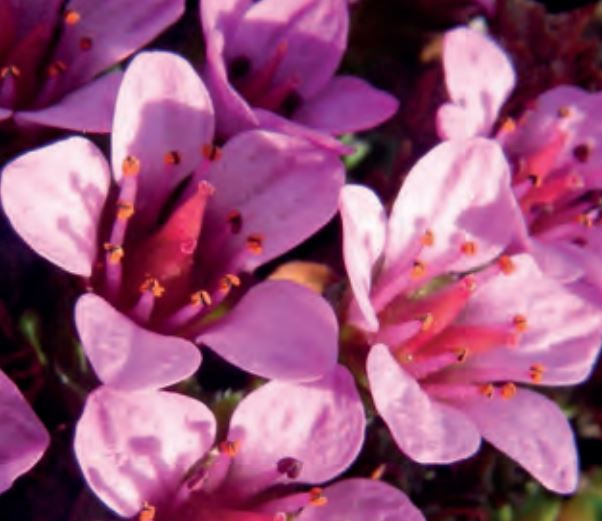You are here: Home | Resources
| Cultivation Advice
Plant Portraits - Saxifraga oppositifolia
by Mike Kendall and John Owen
Even before landing, it was easy to see that the ground around the Polish polar research base in Hornsund on the island of Spitzbergen (78°N) was covered by a purple haze. Coming ashore from the boat, it was evident that the colour came from vast numbers of Purple Saxifrage. We are far more used to seeing it high in the Alps, in small numbers. In Spitzbergen it forms extensive mats covering everything from stony terraces above the seashore to the tussocks that rise from wet summer meadows and the edges of snow banks. It is so common that, given a few days, an alpine gardener can actually bring himself to walk across the vibrantly coloured flowers while moving around the scientific base. It is hard to treat a plant this special in the same way as you would the dandelions or daisies on your lawn but, if you are on your way to the dining room after a hard day in the field, inhibitions are easily overcome!
Here in Scotland we also find Purple Saxifrage close to the sea. If you visit Invernaver or Faraid Head in Sutherland in the spring, the show will not be as spectacular as that in the Arctic but you will easily find plants not too far away from your car. Skye also has this species close to the coast but there it is easier to find it in the Cuillin or Trotternish mountains.
Further south still, it can be found on most Scottish mountains, in the Lake District and even in Snowdonia. Purple Saxifrage tends to be a plant of cool, moist, northward and eastward facing corries. In the Alps it is a high mountain plant, flowering briefly as the snow melts. The later in the year that you visit, the higher you have to go to find it.
We have encountered Saxifraga oppositifolia in so many places, from skyline to coastline, that it is scarcely surprising it has become a personal favourite in the garden. It was a struggle to keep it happy in a well-drained trough in Devon but when the same plant was moved to the Highlands in a large pan, it suddenly began to thrive. It was not long before it needed to be vigorously divided! It now occupies two large patches of alpine bed. Every spring, in mid-April, it covers itself with flowers, reminding us that even the most common of alpine plants is to be treasured.
Cultivation Saxifraga oppositifolia is relatively simple to cultivate … if it is happy. It likes a wide range of conditions, both acidic and calcareous, although forms may reflect their origins in their preferences. Composts need to be quite gritty to ensure good drainage, but moisture-retentive enough to prevent it from drying out.
Full sun all day is not its first choice. This far north, that is not likely to be a problem but a cool root-run is nevertheless essential, especially if grown in a trough. Very weak feeding in spring if it is in a container will maintain its vigour. Overfeeding is not recommended.
Propagation Propagation by cuttings in spring is easy, using a similar, low-nutrient compost. Again, ample moisture is essential. New plants should be able to be potted on within four to six weeks.
|